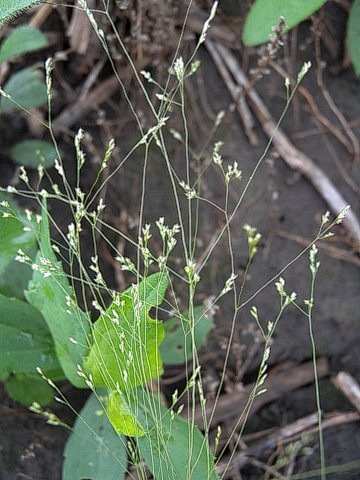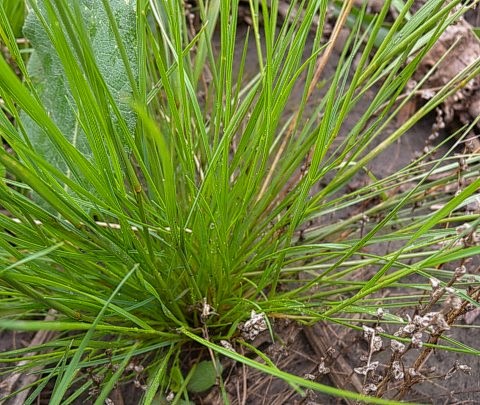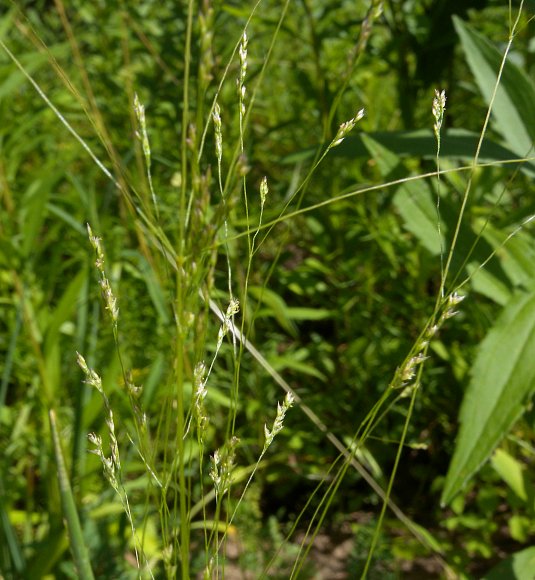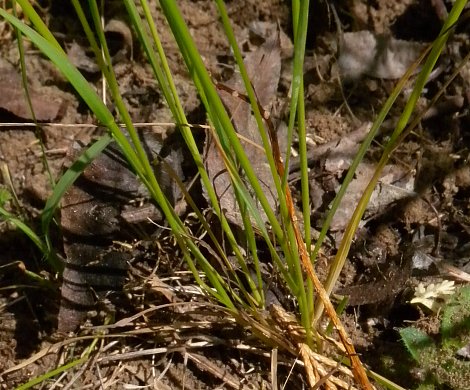Description: This perennial grass consists of a small tuft of leafy culms about 1-2' tall. Both taller fertile shoots and lower infertile shoots are present. The slender culms are erect to ascending, terete, light to medium green, and glabrous. Each fertile shoot has 3-4 alternate leaves along its culm. The leaf blades of fertile shoots are 1-2 mm. across and 2-4" long; they are medium green, ascending, glabrous, and somewhat stiff. The leaf blades of infertile shoots are similar, except they are shorter (about 2" or less) and more narrow (1 mm. across). The leaf sheaths of both fertile and infertile shoots are medium green, veined, glabrous, and slightly rough-textured; they wrap tightly around the culms. At the junction of each leaf blade and sheath, the short ligule consists of a papery membrane about 1-2 mm. long. The nodes along the culms are slightly swollen, hairless, and dark-colored.

The culm of each fertile shoot terminates in an inflorescence consisting of a panicle of spikelets about 6-9" long and a little less across; when it is fully open, this panicle has widely spreading branches and an airy appearance. These branches are very slender, somewhat stiff, light green to pale purple, hairless, and slightly rough-textured. Lateral branches about 2-4" long occur at intervals along the central axis of the panicle in whorls of 2-3; they are naked and do not divide into branchlets except at their tips. The outer branchlets bear small clusters of whitish green to pale purple spikelets. Each single-flowered spikelet is 1-2 mm. long, consisting of a pair of glumes and a tiny lemma (0.5–1.0 mm.). The glumes resemble a pair of tiny claws; they are not appressed together. Each glume is 1-2 mm. long, elliptic in shape, and convex along its outer surface. The blooming period can occur from mid-spring to mid-summer; the florets of the spikelets are wind-pollinated. Each spikelet can produce a single ellipsoid grain about 0.5–1.0 mm. long.

Later in the year,
the entire inflorescence breaks off at the base and rolls across the
ground like a tumbleweed. The spikelets disarticulate from the
inflorescence above the glumes. The root system consists of a tuft of
shallow fibrous roots. This grass reproduces by reseeding itself.
Cultivation:
The preference is full sun, mesic to dry conditions, and barren soil
containing gravel or sand. However, this grass also adapts to rich
loamy soil in disturbed areas.
Range & Habitat:
Tickle Grass is occasional to locally common throughout Illinois, where
it is native (see Distribution
Map).
Habitats include hill prairies, gravel prairies, sand prairies, thin
upland woodlands and eroded slopes, abandoned fields and pastures, and
early stages of prairie restorations. Tickle Grass is a pioneer species
that is more common in habitats that are disturbed and degraded.

Faunal
Associations:
The caterpillars of several skippers feed on the foliage of Agrostis
spp. (Bent Grasses) in sunny areas. These species include Amblyscirtes
vialis (Common Roadside Skipper), Hesperia leonardus
(Leonard's Skipper), and Hylephila phyleus (Fiery
Skipper). Other insect feeders of these grasses include Rhopalosiphum oxyacanthae
(Apple-Grass Aphid) and other aphids, adults of Philaenarcys bilineata
(Prairie Spittlebug), Chaetocnema
denticulata (Toothed Flea Beetle), leaf-mining larvae of
the moth Elachista
illectella, and larvae of the gall wasp Tetramesa agrostidis.
Larvae of the latter insect form galls on the stems.
Photographic Location:
A restoration at the Loda Cemetery Prairie in east-central Illinois,
and a degraded prairie in Vermilion County, Illinois.

Comments: Tickle Grass has a very distinctive inflorescence because its branches are largely naked and its awnless spikelets are largely restricted toward the tips of the outermost branchlets. The only other grass species in Illinois with this kind of inflorescence is Agrostis scabra (Rough Bent Grass). Rough Bent Grass differs by its wider leaf blades (2-6 mm. across), its larger spikelets (2-3 mm. long), and its glumes, which are appressed together; otherwise these two species of grass are very similar. Another similar species that can be found in southern Illinois, Agrostis elliottiana (Awned Bent Grass), is an annual grass with awned spikelets. In general, grasses in this genus have small single-flowered spikelets; each of these spikelets has a pair of elongated glumes and a smaller lemma in the middle.